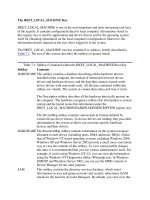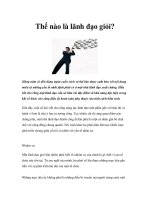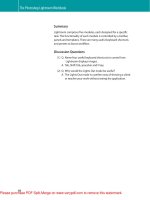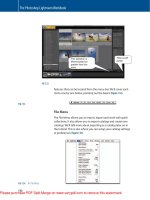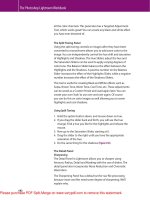Tài liệu The Options Course Workbook Second Edition ppt
Bạn đang xem bản rút gọn của tài liệu. Xem và tải ngay bản đầy đủ của tài liệu tại đây (1.55 MB, 236 trang )
The
Options
Course
Workbook
ffirs.qxd 12/27/04 2:58 AM Page i
Founded in 1807, John Wiley & Sons is the oldest independent publishing
company in the United States. With offices in North America, Europe, Aus-
tralia, and Asia, Wiley is globally committed to developing and marketing
print and electronic products and services for our customers’ professional
and personal knowledge and understanding.
The Wiley Trading series features books by traders who have survived
the market’s ever changing temperament and have prospered—some by
reinventing systems, others by getting back to basics. Whether a novice
trader, professional, or somewhere in-between, these books will provide
the advice and strategies needed to prosper today and well into the future.
For a list of available titles, visit our web site at www.WileyFinance.com.
ffirs.qxd 12/27/04 2:58 AM Page ii
The
Options
Course
Workbook
Second Edition
Step-by-Step Exercises and
Tests to Help You Master
The Options Course
GEORGE A. FONTANILLS
John Wiley & Sons, Inc.
ffirs.qxd 12/27/04 2:58 AM Page iii
Copyright © 2005 by George A. Fontanills and Richard Cawood. All rights reserved.
Published by John Wiley & Sons, Inc., Hoboken, New Jersey.
Published simultaneously in Canada.
No part of this publication may be reproduced, stored in a retrieval system, or transmitted
in any form or by any means, electronic, mechanical, photocopying, recording, scanning, or
otherwise, except as permitted under Section 107 or 108 of the 1976 United States Copyright
Act, without either the prior written permission of the Publisher, or authorization through
payment of the appropriate per-copy fee to the Copyright Clearance Center, Inc.,
222 Rosewood Drive, Danvers, MA 01923, 978-750-8400, fax 978-646-8600, or on the web at
www.copyright.com. Requests to the Publisher for permission should be addressed to the
Permissions Department, John Wiley & Sons, Inc., 111 River Street, Hoboken, NJ 07030,
201-748-6011, fax 201-748-6008.
Limit of Liability/Disclaimer of Warranty: While the publisher and author have used their
best efforts in preparing this book, they make no representations or warranties with respect
to the accuracy or completeness of the contents of this book and specifically disclaim any
implied warranties of merchantability or fitness for a particular purpose. No warranty may
be created or extended by sales representatives or written sales materials. The advice and
strategies contained herein may not be suitable for your situation. You should consult with a
professional where appropriate. Neither the publisher nor author shall be liable for any loss
of profit or any other commercial damages, including but not limited to special, incidental,
consequential, or other damages.
For general information on our other products and services, or technical support, please
contact our Customer Care Department within the United States at 800-762-2974, outside
the United States at 317-572-3993 or fax 317-572-4002.
Wiley also publishes its books in a variety of electronic formats. Some content that appears
in print may not be available in electronic books.
For more information about Wiley products, visit our web site at www.wiley.com.
ISBN 0-471-69421-5
Printed in the United States of America.
10987654321
ffirs.qxd 12/27/04 2:58 AM Page iv
To our global community
that we may strive to create
a peaceful world
for all our children.
ffirs.qxd 12/27/04 2:58 AM Page v
ffirs.qxd 12/27/04 2:58 AM Page vi
Contents
CHAPTER 1 Options Trading: A Primer 1
CHAPTER 2 The Big Picture 9
CHAPTER 3 Option Basics 31
CHAPTER 4 Basic Trading Strategies 53
CHAPTER 5 Introducing Vertical Spreads 67
CHAPTER 6 Demystifying Delta 79
CHAPTER 7 The Other Greeks 87
CHAPTER 8 Straddles, Strangles, and Synthetics 100
CHAPTER 9 Advanced Delta Neutral Strategies 116
CHAPTER 10 Trading Techniques for
Range-Bound Markets 129
CHAPTER 11 Increasing Your Profits
with Adjustments 141
CHAPTER 12 Choosing the Right Broker 149
CHAPTER 13 Processing Your Trade 159
CHAPTER 14 Margin and Risk 170
CHAPTER 15 A Short Course in
Economic Analyses 181
vii
ftoc.qxd 12/27/04 2:58 AM Page vii
CHAPTER 16 Mastering the Market 188
CHAPTER 17 How to Spot Explosive Opportunities 194
CHAPTER 18 Tools of the Trade 212
CHAPTER 19 Final Summary 218
viii
CONTENTS
ftoc.qxd 12/27/04 2:58 AM Page viii
The
Options
Course
Workbook
flast.qxd 12/27/04 2:59 AM Page ix
flast.qxd 12/27/04 2:59 AM Page x
CHAPTER 1
Options
Trading:
A Primer
SUMMARY
Starting to trade options can be stressful and unsettling, but it doesn’t have
to be. By learning to trade options systematically and by fostering a patient
approach, a new trader can become successful. Options trading requires
an understanding of the characteristics of options and this takes time to
master. Nonetheless, a person who is willing to study and work hard can
achieve success.
To become successful at trading options, you need to focus on three
important features of options: duration, direction, and magnitude. If un-
derstood, the interrelation of these three issues can provide the edge
needed to win at options trading. There are, however, some stepping-
stones that need to be put in place before jumping headlong into the op-
tions game. Following the suggestions in this book will enable you to
gain the knowledge and skills necessary to trade profitably. Mainly, a
new trader should start small, not placing too much capital in any one
trade initially. New traders should also paper trade strategies to get a
better feel for how each strategy works. Any trader, new or experi-
enced, should define the risk before entering any trade. Only consistent
risk managers make it in the trading profession; so do your homework
and follow the steps outlined in this book.
1
ccc_opwkbk_ch1_1-8.qxd 12/9/04 10:35 PM Page 1
QUESTIONS AND EXERCISES
1. True or False: Just because someone is licensed to place a trade does
not mean the person has the knowledge to invest your money wisely.
2. What is the difference between an investor and a trader?
____________________________________________________________
____________________________________________________________
____________________________________________________________
3. Successful options traders use only ________________ that are read-
ily available and can be invested in a sound manner.
A. Options.
B. Funds.
C. Futures.
D. Stocks.
4. It is critical to accurately assess your ______________ to determine
the style of investing that suits you best.
A. Flexibility.
B. Interest.
C. Markets.
D. Time constraints.
5. How can you minimize your losses when you first begin trading
options?
A. Start small.
B. Learn to paper trade.
C. Interview several brokers before picking the one most suited to
your needs.
D. All of the above.
6. What is the most important factor for building a low-stress invest-
ment strategy?
A. Understanding your markets.
B. Having a good broker.
C. Defining your risk in every trade.
D. Learning to paper trade first.
2
THE OPTIONS COURSE WORKBOOK
ccc_opwkbk_ch1_1-8.qxd 12/9/04 10:35 PM Page 2
7. ______________ allows a trader to cultivate a matrix of strategies
with which to respond to market movement in any direction.
A. Flexibility.
B. Specializing.
C. Computer access.
D. Confidence.
8. Successful investors usually ______________ in just one or in a few
areas. This allows them to develop strategies that work in certain
recognizable market conditions.
A. Specialize.
B. Win.
C. Go short.
D. Systematically invest.
9. To become a successful options trader you have to have
______________.
A. Lots of money to invest.
B. Patience and persistence.
C. A computer.
D. A good sense of market direction.
MEDIA ASSIGNMENT
The Internet is a great resource for new and experienced traders. Not only
can traders place trades online, but there is a plethora of free options in-
formation that can be easily accessed. For example, the Optionetics web
site has a wide range of information and numerous articles that can foster
profitable trading for both new and experienced traders. Take the time to
become familiar with the Optionetics site in order to benefit from the
tools and information found there. This is also a great starting point to
find a broker. The site offers a section dedicated to providing in-depth
information about the various options brokers out there. Take the time to
review this information so you’ll be prepared to open a brokerage account
when the time comes.
Options Trading: A Primer 3
ccc_opwkbk_ch1_1-8.qxd 12/9/04 10:35 PM Page 3
VOCABULARY LIST
SOLUTIONS
1. True or False: Just because someone is licensed to place a trade does
not mean the person has the knowledge to invest your money wisely.
Answer: True.
Discussion: Unfortunately, obtaining a license to place a trade does
not necessarily make someone a good trader. Like many things in life,
sometimes book knowledge isn’t enough to create success. When
learning to drive a car, someone doesn’t just immediately move out
onto the freeway after reading a book. Though having a license does
teach some important things, it isn’t a guarantee that the person will
be successful at trading.
2. What is the difference between an investor and a trader?
Answer: An investor takes a long-term, passive approach. A trader
takes a more active approach using various options strategies that
tend to capitalize on shorter-term market movement.
Discussion: As the term implies, an investor is investing his/her
money into a company by buying stock in it. A trader isn’t necessarily
concerned with ownership, just profits and short-term gains. Most in-
vestors are people who buy and hold stock or mutual funds; they are
more in step with the Warren Buffett approach to long-term security.
A trader seeks profits in the short term, trading stocks and options
4
THE OPTIONS COURSE WORKBOOK
Bear
Broker
Bull
Call
Capital
Delta neutral
Go long
Go short
Investor
Leverage
Paper trading
Put
Return
Risk
Risk management
Stop loss
Trader
ccc_opwkbk_ch1_1-8.qxd 12/9/04 10:35 PM Page 4
with a clear eye on risk management and a friendly ear for volatility.
Undoubtedly there are many who dabble somewhere in between.
3. Successful options traders use only ______________ that are readily
available and can be invested in a sound manner.
Answer: B—Funds.
Discussion: Though Optionetics teaches traders how to use options
to limit risk, there still is a chance that the capital used in trading op-
tions could all be lost. As a result, it is wise to only use money that is
not needed for bills or other important necessities in life. If you trade
using capital you cannot afford to lose, it is very difficult to trade
without letting your emotions get in the way.
4. It is critical to accurately assess your ______________ to determine
the style of investing that suits you best.
Answer: D—Time constraints.
Discussion: If the capital you plan on using to trade options is also
needed for an important life event in the next year or two, it is unwise
to use it. Though quick profits can often be made trading options, we
still need to trade with a long-term goal in mind. Even a successful
options trader might go through a losing streak, and if the capital is
needed during this down time, it can be a difficult situation.
5. How can you minimize your losses when you first begin trading
options?
Answer: D—All of the above (start small, learn to paper trade, inter-
view several brokers before picking the one most suited to your
needs).
Discussion: All of these issues should be used when first starting to
trade options. The nice thing about options is that it doesn’t take a
huge amount of capital to get started. Nonetheless, even if you have a
nice nest egg to begin with, start small. Try to learn how the strategies
work before taking a bigger leap. You may want to paper trade a new
strategy so you won’t lose capital during the learning process. Even
so, there eventually comes a time when the trader will not be able to
learn more until he or she trades with real capital. Using a broker
who gets a trade a good fill and is easy to work with is crucial for the
long-term success of an options trader. With the number of brokers
available, don’t be afraid to change brokers if the one you start with
isn’t working out.
Options Trading: A Primer 5
ccc_opwkbk_ch1_1-8.qxd 12/9/04 10:35 PM Page 5
6. What is the most important factor for building a low-stress invest-
ment strategy?
Answer: C—Defining your risk in every trade.
Discussion: Those who pay attention to Optionetics instructors and
writers will hear this all the time. Options were first developed to
help traders limit risk, and Optionetics still believes this is the key.
We need to know the risk of every trade before we enter it so that we
are prepared for the worst and know what actions are needed to limit
this risk.
7. ______________ allows a trader to cultivate a matrix of strategies
with which to respond to market movement in any direction.
Answer: A—Flexibility.
Discussion: Though it is a good idea to narrow your choice of strate-
gies, this doesn’t mean that a trader shouldn’t have a couple of strate-
gies for each type of market. One of the greatest advantages to
trading options is their flexibility. You can make money in up, down,
and sideways markets using options, so don’t limit yourself to just
bullish strategies.
8. Successful investors usually ______________ in just one or in a few
areas. This allows them to develop strategies that work in certain
recognizable market conditions.
Answer: A—Specialize.
Discussion: Specialization has become the thing to do in any profes-
sion in our day and age. It is no different when trading options.
Though we need to have a wide base of knowledge about options and
trading, we do not need to become experts in every available options
strategy. As you learn about different options strategies, specialize in
the ones that best fit your risk tolerance and expertise.
9. To become a successful options trader you have to have
______________.
Answer: B—Patience and persistence.
Discussion: This is very important to remember. Too many new
traders expect to become millionaires overnight; this is unrealistic.
Traders need to realize that where there is more possible reward,
there is usually a higher degree of risk. Even the most successful op-
tions traders often lose money in individual trades. However, these
traders have learned to limit their risk and have developed a sound
plan that allows them to be patient and persistent.
6
THE OPTIONS COURSE WORKBOOK
ccc_opwkbk_ch1_1-8.qxd 12/9/04 10:35 PM Page 6
MEDIA ASSIGNMENT
Learning to use the Internet to further your understanding of the market
and options is a vital part of your trading education. The free Optionet-
ics web site has a plethora of information. Mainly, take the time to
search for information dealing with the initial strategies you want to
master. As you progress up the learning curve, read the daily articles to
gain an understanding of the markets. You can also read about various
options brokers on the Brokers Review link. This will provide informa-
tion about costs, services, and other important data about most of the
options brokers available.
VOCABULARY DEFINITIONS
Bear: An investor who believes that a security or the market is falling or
is expected to fall.
Broker: An individual or firm that charges a fee or commission for
executing buy and sell orders submitted by another individual or firm.
Bull: An investor who believes that a security or the market is rising or is
expected to rise.
Call: An option contract that gives the holder the right, but not the obliga-
tion, to buy a specified amount of an underlying security at a specified price
within a specified time (e.g., if you buy an IBM January 85 call, you have the
right to buy 100 shares of IBM at $85 each by the third Friday in January).
Capital: The amount of money you have invested. When your investing
objective is capital preservation, your priority is to try not to lose any
money. When your objective is capital growth, your priority is to try
to make your initial investment grow in value. Capital also refers to ac-
cumulated money or goods available for use in producing more money
or goods.
Delta neutral: Refers to an options position constructed so that the prof-
itability of the position relies on the magnitude of the move—not the di-
rectional bias; it is relatively insensitive to the price movement of the
underlying instruments. A delta neutral trade is arranged by selecting a
calculated ratio of short and long positions with a combined delta of zero.
Go long: To buy securities, options, or futures with the intent to profit
from a rise in the price of the assets.
Go short: To sell securities, options, or futures with the intent to profit
from a drop in the price of the assets.
Options Trading: A Primer 7
ccc_opwkbk_ch1_1-8.qxd 12/9/04 10:35 PM Page 7
Investor: A person whose principal concern in the purchase of a secu-
rity is the minimizing of long-term risk, compared to the speculator who
is prepared to accept calculated risk in the hope of making better-than-
average profits, or the gambler who is prepared to take even greater
risks. More generally, it refers to people who invest money in invest-
ment products.
Leverage: Enables a trader to buy or sell a security or derivative and re-
ceive fair value for it using borrowed capital to increase investment return.
Paper trading: Simulating a trade without actually putting up the money,
usually done for the purpose of gaining additional trading experience.
Put: An option contract that gives the owner the right, but not the obliga-
tion, to sell a specified amount of an underlying security at a specified
price within a specified time.
Return: The income earned or a capital gain made on an investment.
Risk: The potential financial loss inherent in an investment.
Risk management: The process of managing trades by hedging risk.
Stop-loss order: An order to sell when the price of the stock declines to,
or below, a stated price. The purpose of this is to reduce the amount of
loss that might occur.
Trader: Someone who buys and sells frequently with the objective of
short-term profit.
8
THE OPTIONS COURSE WORKBOOK
ccc_opwkbk_ch1_1-8.qxd 12/9/04 10:35 PM Page 8
CHAPTER 2
The
Big
Picture
SUMMARY
Trading stocks might be the best-known form of playing the markets, but
many individuals specialize in other lesser-known trading instruments.
This chapter is designed to give the novice trader a comprehensive view of
trading by exploring the wide variety of different trading instruments—in-
cluding stocks, futures, and options—as well as the multitude of ways to
trade them. Particular attention is devoted to trading instrument proper-
ties as well as specific examples.
Options are derivatives, meaning they derive their value from an un-
derlying financial instrument. Though options can be entered using stock
as the underlying security, indexes and futures also have options available.
Futures and options can be used together, but they are two distinctly dif-
ferent instruments and require totally different types of trading accounts.
However, both of these instruments provide increased leverage, which
means a trader can control a large amount of stock or other instrument
with little initial capital outlay.
Options are an extremely versatile instrument and can be used to cre-
ate a variety of different limited risk strategies. However, like most en-
deavors, they require practice and discipline, as well as proper money and
risk management. In addition, traders must pay significant attention to
volatility issues if options are to be successfully utilized. Both historical
and implied volatility are important concepts to understand and should be
studied in depth to master the options trading game.
9
ccc_opwkbk_ch2_9-30.qxd 12/9/04 10:36 PM Page 9
QUESTIONS AND EXERCISES
1. A stock is a unit of ownership in a company. The value of that unit of
ownership is based on a number of factors, including:
____________________________________________________________
____________________________________________________________
2. Six people form a company together and decide that there will be
only six shareholders with only one share each. If this company’s as-
sets total $90,000 and it has $15,000 in liabilities, how much is each
share worth?
A. $15,000.
B. $12,500.
C. $10,000.
D. $7,500.
3. The computerized market, ______________, is also referred to as the
over-the-counter (OTC) market.
A. Securities and Exchange Commission.
B. Chicago Board Options Exchange.
C. Nasdaq.
D. FOREX.
4. Supply and demand for a company’s shares helps to create
______________.
A. Momentum.
B. Historical volatility.
C. Liquidity.
D. Time decay.
5. If investors feel a company will beat Wall Street expectations, then
the price of the shares will be ______________ as there will be more
buyers than sellers.
A. Higher.
B. Lower.
C. Bid up.
D. Offer down.
10
THE OPTIONS COURSE WORKBOOK
ccc_opwkbk_ch2_9-30.qxd 12/9/04 10:36 PM Page 10
6. If the majority of investors feel that the company’s earnings will
disappoint the Street, then the prices will be ______________.
A. Higher.
B. Lower.
C. Bid up.
D. Offer down.
7. If there are more bidders (buyers), prices will ______________. If
there are more people offering (sellers), prices will ______________.
A. Fall. Rise.
B. Rise. Fall.
C. Stay the same.
D. Be impossible to predict.
8. A company’s board of directors decides whether to declare
______________ from time to time to be paid out and distributed to
shareholders on a payable date.
A. Better than expected earnings.
B. Revised expected earnings.
C. Cash flow.
D. A dividend.
9. What are the four unofficial size classifications of stocks?
1. _________________________________________________________
2. _________________________________________________________
3. _________________________________________________________
4. _________________________________________________________
10. The ______________, which reports the performance of 30 major
companies representing key industries, is the most widely quoted
indicator of market performance.
A. Standard & Poor’s Index.
B. Amex Market Value Index.
C. New York Stock Exchange Composite Index.
D. Dow Jones Industrial Average.
The Big Picture 11
ccc_opwkbk_ch2_9-30.qxd 12/9/04 10:36 PM Page 11
11. Name a few stock sectors.
____________________________________________________________
____________________________________________________________
12. What is the difference between a futures contract and an options
contract?
____________________________________________________________
____________________________________________________________
13. ______________ were initially used by farmers and producers of
products to hedge themselves or lock in prices for a certain crop or
product cycle.
A. Options contracts.
B. Futures contracts.
C. Stock contracts.
D. All of the above.
14. True or False: Hedgers use futures trading to lock in prices and
protect themselves from market movement because they are pri-
marily interested in actually receiving or selling the commodities
themselves.
15. ______________ do not expect to take delivery of a product; they are
in the futures market to try to make money on the price movement of
a futures contract.
A. Producers.
B. Speculators.
C. Hedgers.
D. Farmers.
16. If you believe soybean prices will rise over the next three months,
based on whatever information you may have, you could __________
the corn futures three months out hoping to make a profit.
A. Go long.
B. Go short.
C. Hedge.
D. All of the above.
12 THE OPTIONS COURSE WORKBOOK
ccc_opwkbk_ch2_9-30.qxd 12/9/04 10:36 PM Page 12
17. If you believe corn prices will fall during this same period, you
could ______________ the corn futures contract three months out
hoping to make a profit.
A. Go long.
B. Go short.
C. Hedge.
D. All of the above.
18. Physical commodities are any bulk good traded on an exchange or in
the cash market; examples include grains, meats, metals, and ener-
gies. _________________ include debt instruments (such as bonds),
currencies, and indexes.
A. Index futures.
B. ETFs.
C. Financial commodities.
D. HOLDRS.
19. The value of ______________ primarily depends on interest rates.
A. Bonds.
B. Debt instruments.
C. Eurodollars.
D. All of the above.
20. Typically, there is an inverse relationship between ______________
and most foreign currencies.
A. The U.S. dollar.
B. Interest rates.
C. Bonds.
D. All of the above.
21. A/an ______________ is an indicator that is used to measure and
report value changes in a specific group of stocks, commodities, or
different sectors of the marketplace.
A. Bond.
B. Moving average.
C. Index.
D. All of the above.
The Big Picture 13
ccc_opwkbk_ch2_9-30.qxd 12/9/04 10:36 PM Page 13
22. By combining futures with ______________, you can create trades in
which you limit your risk and maximize your potential profits.
A. Options.
B. HOLDRS.
C. Futures contracts.
D. All of the above.
23. ______________ are contracts between two parties that convey to
the buyer a right, but not an obligation, to buy or sell a specific
commodity or stock at a specific price within a specific time period
for a premium.
A. Stocks.
B. Futures.
C. Options.
D. All of the above.
24. The price of an option is referred to as the ______________.
A. Premium.
B. Strike price.
C. Bid-ask price.
D. Price-earnings (P/E) ratio.
25. The ______________ is defined as the price at which the stock or
commodity underlying a call or put option can be purchased or sold
over the specified period.
A. Premium.
B. Strike price.
C. Bid-ask price.
D. Price-earnings (P/E) ratio.
26. An option is no longer valid after its ______________.
A. Payable date.
B. Expiration date.
C. Exercise date.
D. Assignment date.
27. True or False: Options are available on all stocks.
14 THE OPTIONS COURSE WORKBOOK
ccc_opwkbk_ch2_9-30.qxd 12/9/04 10:36 PM Page 14

